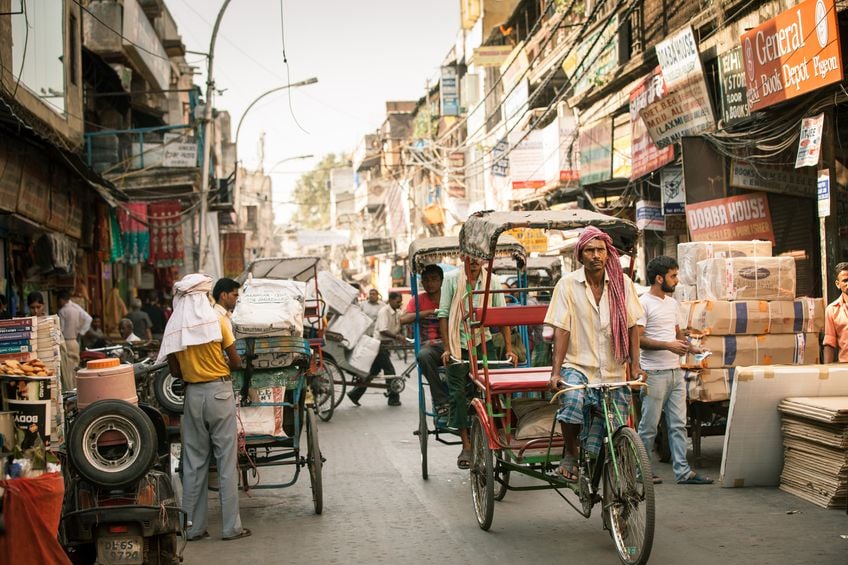Say namaste to legacies of the Mughal Empire and uncover the feverish energy of the bazaars that occupy every nook and cranny of India’s largest cities by experiencing the Golden Triangle tour. Exploring India’s hectic, bewitching ancient cities and exquisite marble tombs, this is the classic Indian circuit and an ideal introduction to the country’s eclectic cultural heritage – particularly for those with limited time for travel.
What are the main stops on the Golden Triangle tour?
Named after the equilateral triangle shape that Delhi, Agra and Jaipur form on the map, the Golden Triangle tour visits these three cities in north-west India. The tour normally begins in the capital city, Delhi, before passing by train to Agra and finishing in Jaipur.
Delhi
The initial stop on the Golden Triangle tour, this city embodies the dual identities of modern and ancient India. The streets of Old Delhi – the area once ruled by the Mughals – teem with rickshaws, while the archetypal Indian bazaars vye for your attention with brightly dyed fabrics or freshly cut, sweetly scented flowers. In the British constructed quarter, New Delhi, wide, tree-lined avenues and a plethora of museums show Delhi’s multifarious architecture and history.
 For a better understanding of India’s religious heritage, tourists normally head to Jama Masjid (Grand Mosque). India’s largest, thousands congregate to worship at this red sandstone, 17th-century mosque every Friday – a captivating spectacle for visitors to the city.
For a better understanding of India’s religious heritage, tourists normally head to Jama Masjid (Grand Mosque). India’s largest, thousands congregate to worship at this red sandstone, 17th-century mosque every Friday – a captivating spectacle for visitors to the city.
Agra
The location of the most famous of all Indian landmarks, Agra is the next stop on the Golden Triangle tour. The Mughal-era building, the Taj Mahal, is the star of northern India – a mesmerizing marble mausoleum which was built in the 1600s at the request of Mughal emperor, Shah Jahan, to house the deceased body of his favourite wife.
Over eight million tourists visit annually to absorb the magical vistas of the ivory-white minarets or to watch sunset over this ethereal symbol of Indian culture which is one of the new Seven Wonders of the World.
 Nearby Akbar’s Mausoleum is another important Agran landmark. One of the most ambitious of all of the Mughal built tombs, it’s a delightful complex of marble minarets ornamented with coloured tiles, set in sweeping gardens and presided over by the enormous Buland Darwaza – the Great Gate through which you enter. The mausoleum provides a tranquil setting from which to escape the fervent traffic and winding maze of Agra’s streets.
Nearby Akbar’s Mausoleum is another important Agran landmark. One of the most ambitious of all of the Mughal built tombs, it’s a delightful complex of marble minarets ornamented with coloured tiles, set in sweeping gardens and presided over by the enormous Buland Darwaza – the Great Gate through which you enter. The mausoleum provides a tranquil setting from which to escape the fervent traffic and winding maze of Agra’s streets.
Jaipur
The third and final point on the triangle, Jaipur is nicknamed the “Pink City” due to the color of the buildings at its core. Jaipur’s bustling streets swarm with some of the most colourful bazaars in all of India; famed as the finest spots for purchasing jewellery and textiles in the whole country. This city is also the site of the Royal City Palace where visitors can explore the extravagant rooms and even the Armoury, which contains a terrifying display of traditional weapons.
 Amongst Jaipur’s vast array of stunning architecture, the Hawa Mahal or “Palace of the Winds” is a five-storey building east of the Royal City Palace – and which is an unmissable sight in the soft glow of dawn. Constructed in 1799 to permit the court’s women to watch the activities of the street below from the security of screened niches, nowadays it is a place of respite from the hustle of daily life.
Amongst Jaipur’s vast array of stunning architecture, the Hawa Mahal or “Palace of the Winds” is a five-storey building east of the Royal City Palace – and which is an unmissable sight in the soft glow of dawn. Constructed in 1799 to permit the court’s women to watch the activities of the street below from the security of screened niches, nowadays it is a place of respite from the hustle of daily life.
A couple of miles east of the city, visitors encounter a range of 250-year-old temples in Glata and the five thousand macaque monkeys who spend their day bathing in the region’s natural freshwater pools.
Finishing the Golden Triangle tour, visitors normally return to Delhi for their flights out of the country.
No comments yet
There are no comments on this post yet.






Leave a comment